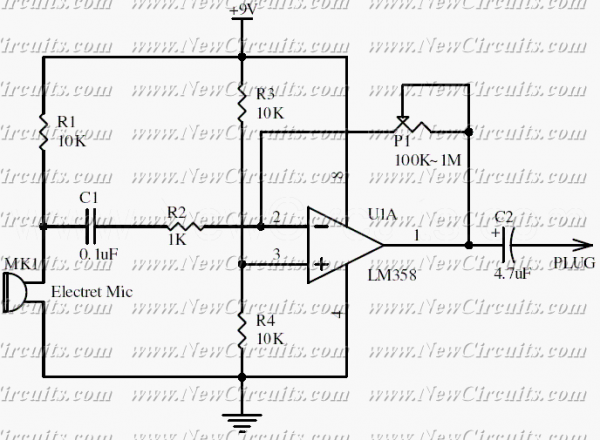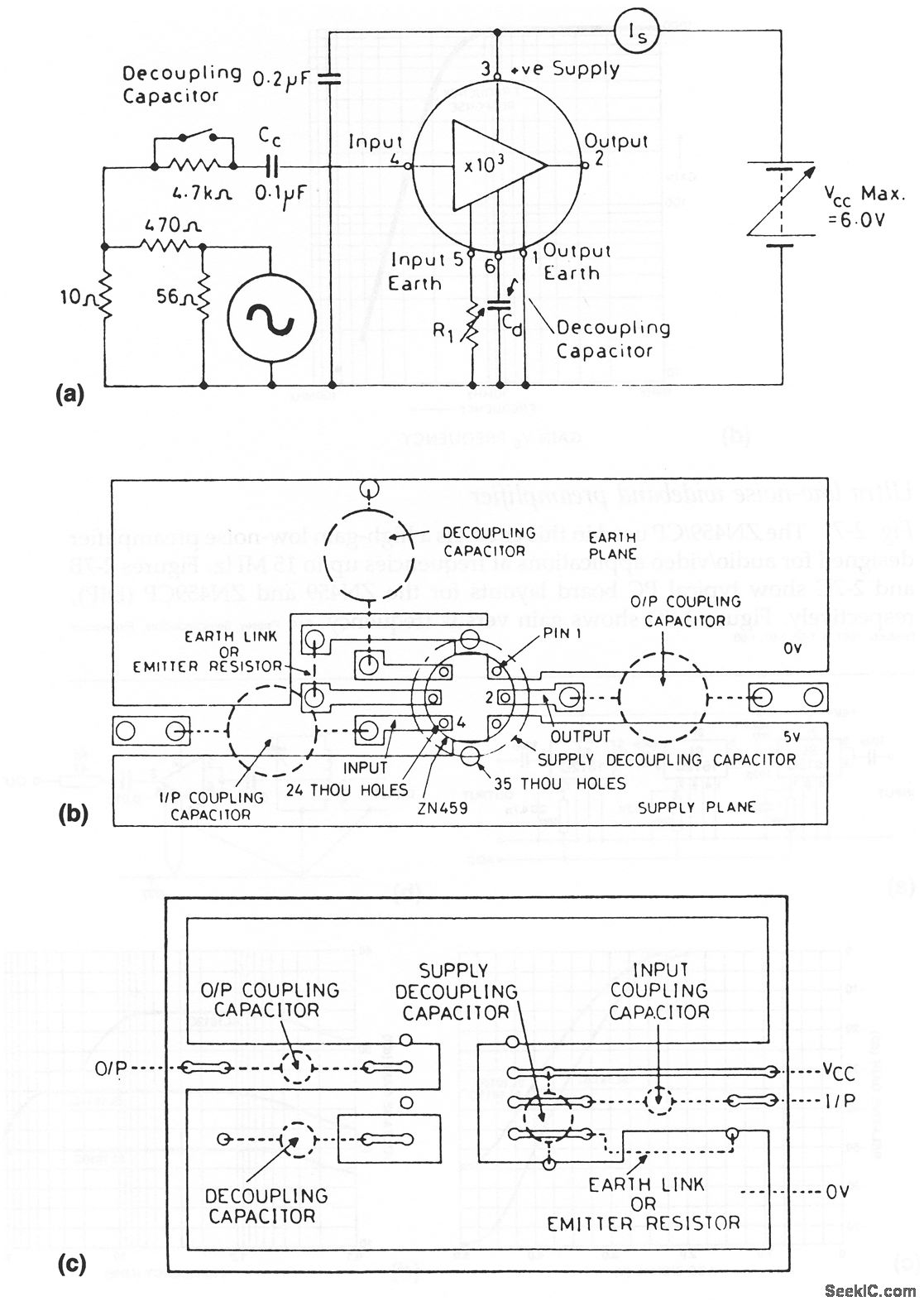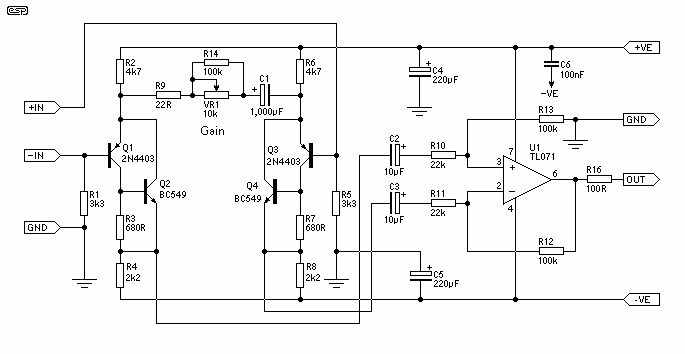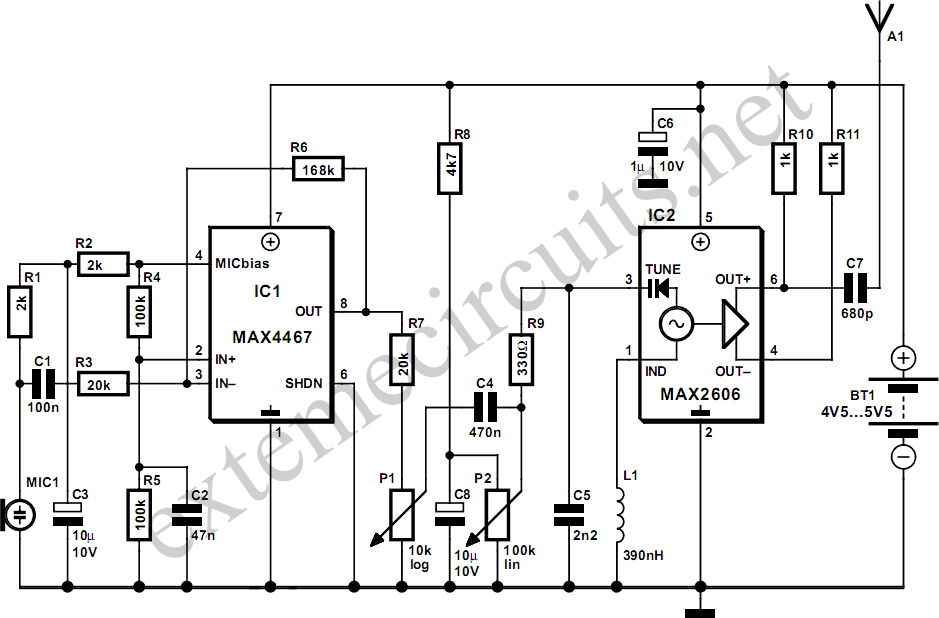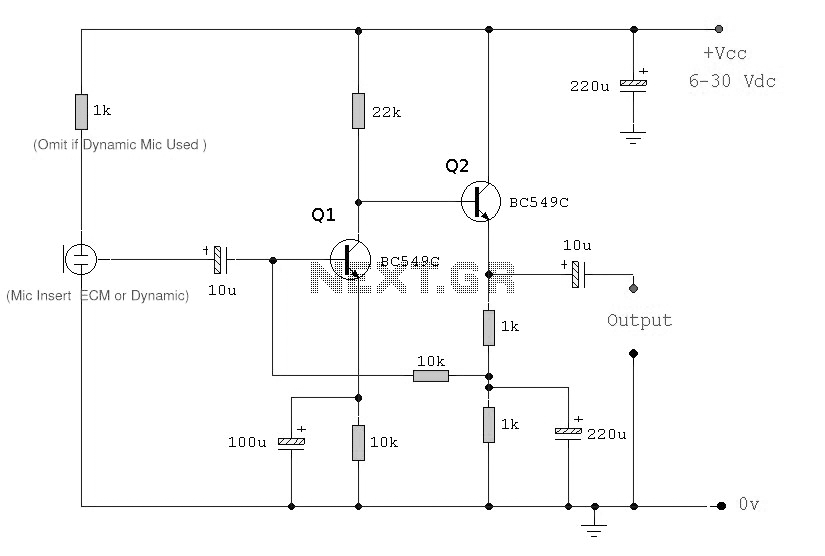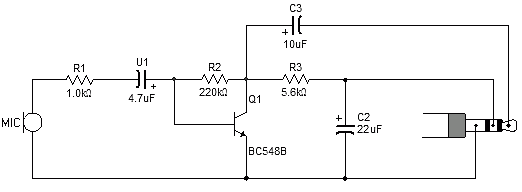
Balanced Microphone Preamplifier
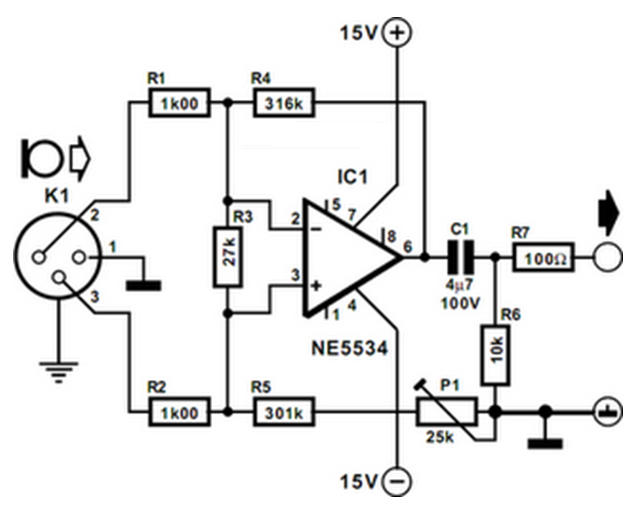
The preamplifier is designed for use with dynamic (moving coil MC) microphones with an impedance of up to 200 ohms and balanced terminals. It features a straightforward design and can be regarded as a single-stage instrument amplifier utilizing a Type NE5534 operational amplifier. To ensure maximum common-mode rejection (CMR) with a balanced signal, the divider ratios of the resistors (R1-R4 and R2-R5) at the op-amp inputs must be identical. To facilitate this, a preset potentiometer, P1, is connected in series with R5, allowing for optimal adjustment of the common-mode rejection. Capacitor C1 blocks any direct voltage at the input, while resistor R7 contributes to the stability of the amplifier with capacitive loads. Resistor R3 helps prevent oscillation when the input is open circuit; however, if the microphone cable is of adequate length, R3 may not be necessary, as the cable's parasitic capacitance can ensure stability. It is important to note that including R3 enhances the CMR from greater than 70 dB to over 80 dB. The preamplifier demonstrates excellent performance, with a total harmonic distortion plus noise (THD+N) of less than 0.1% at an input signal of 1 mV and a source impedance of 50 ohms. Under these conditions, the signal-to-noise ratio is 62.5 dBA. With the specified component values, the amplifier achieves a gain of 50 dB (316). After fine-tuning P1 at 1 kHz, the CMR, without R3, reaches 120 dB. The supply voltage is ±15 V, and the amplifier operates at a current draw of approximately 5.5 mA. It is also important to note the decoupling of the supply lines using inductors L1, L2 and capacitors C2, C5.
This preamplifier circuit is primarily based on the NE5534 op-amp, which is known for its low noise and high-performance characteristics, making it suitable for audio applications. The balanced input design is crucial for minimizing noise and interference, especially in professional audio settings. The use of matched resistor pairs (R1-R4 and R2-R5) ensures that any common-mode signals are effectively rejected, enhancing the overall fidelity of the audio signal.
The inclusion of the preset potentiometer P1 allows for fine-tuning of the common-mode rejection ratio, which is critical in environments where electromagnetic interference may be present. The capacitor C1 plays a vital role in protecting the op-amp from any DC offset that may be present at the microphone output, thus ensuring that only the AC audio signal is amplified. Resistor R7 is essential for maintaining stability when driving capacitive loads, which can otherwise lead to undesirable oscillations.
R3 serves a dual purpose; while it can be omitted in cases where the microphone cable length provides sufficient parasitic capacitance, its inclusion significantly boosts the CMR, thereby improving the overall performance of the preamplifier. The performance metrics indicate that this circuit can handle low-level signals with high fidelity, making it ideal for use in high-quality audio recording and amplification systems.
The power supply configuration of ±15 V is standard for many op-amp circuits, providing sufficient headroom for audio signals while keeping the current consumption at a manageable level. The current draw of 5.5 mA indicates that this circuit is energy-efficient, which is beneficial for battery-operated or portable applications.
Finally, the decoupling of the supply lines with inductors L1, L2, and capacitors C2, C5 is a critical design consideration that helps to filter out any power supply noise, ensuring that the op-amp operates with a clean and stable voltage. This attention to detail in the power supply design further enhances the reliability and performance of the preamplifier circuit.The preamplifier is intended for use with dynamic (moving coil MC) microphones with an impedance up to 200 © and balanced terminals. It is a fairly simple design, which may also be considered as a single stage instrument amplifier based on a Type NE5534 op amp.
To achieve maximum common-mode rejection (CMR) with a balanced signal, the division ratios of the dividers (R1-R4 and R2-R5 respectively) at the inputs of the op amp must be identical. Since this may be difficult to achieve in practice, a preset potentiometer, P1, is connected in series with R5. The preset enables the common-mode rejection to be set optimally. Capacitor C1 prevents any direct voltage at the input, while resistor R7 ensures stability of the amplifier with capacitive loads.
Resistor R3 prevents the amplifier going into oscillation when the input is open circuit. If the microphone cable is of reasonable length, R3 is not necessary, since the parasitic capacitance of the cable ensures stability of the amplifier. It should be noted, however, that R3 improves the CMR from >70 dB to >80 dB. Performance of the preamplifier is very good. The THD+N (total harmonic distortion plus noise) is smaller than 0. 1% with an input signal of 1 mV and a source impedance of 50 ©. Under the same conditions, the signal-to-noise ratio is 62. 5 dBA. With component values as specified, the gain of the amplifier is 50 dB ( 316). After careful adjustment of P1 at 1 kHz, the CMR, without R3, is 120 dB. The supply voltage is ±15 V. The amplifier draws a current at that voltage of about 5. 5 mA. Note the decoupling of the supply lines with L1, L2, C2 C5. 🔗 External reference
This preamplifier circuit is primarily based on the NE5534 op-amp, which is known for its low noise and high-performance characteristics, making it suitable for audio applications. The balanced input design is crucial for minimizing noise and interference, especially in professional audio settings. The use of matched resistor pairs (R1-R4 and R2-R5) ensures that any common-mode signals are effectively rejected, enhancing the overall fidelity of the audio signal.
The inclusion of the preset potentiometer P1 allows for fine-tuning of the common-mode rejection ratio, which is critical in environments where electromagnetic interference may be present. The capacitor C1 plays a vital role in protecting the op-amp from any DC offset that may be present at the microphone output, thus ensuring that only the AC audio signal is amplified. Resistor R7 is essential for maintaining stability when driving capacitive loads, which can otherwise lead to undesirable oscillations.
R3 serves a dual purpose; while it can be omitted in cases where the microphone cable length provides sufficient parasitic capacitance, its inclusion significantly boosts the CMR, thereby improving the overall performance of the preamplifier. The performance metrics indicate that this circuit can handle low-level signals with high fidelity, making it ideal for use in high-quality audio recording and amplification systems.
The power supply configuration of ±15 V is standard for many op-amp circuits, providing sufficient headroom for audio signals while keeping the current consumption at a manageable level. The current draw of 5.5 mA indicates that this circuit is energy-efficient, which is beneficial for battery-operated or portable applications.
Finally, the decoupling of the supply lines with inductors L1, L2, and capacitors C2, C5 is a critical design consideration that helps to filter out any power supply noise, ensuring that the op-amp operates with a clean and stable voltage. This attention to detail in the power supply design further enhances the reliability and performance of the preamplifier circuit.The preamplifier is intended for use with dynamic (moving coil MC) microphones with an impedance up to 200 © and balanced terminals. It is a fairly simple design, which may also be considered as a single stage instrument amplifier based on a Type NE5534 op amp.
To achieve maximum common-mode rejection (CMR) with a balanced signal, the division ratios of the dividers (R1-R4 and R2-R5 respectively) at the inputs of the op amp must be identical. Since this may be difficult to achieve in practice, a preset potentiometer, P1, is connected in series with R5. The preset enables the common-mode rejection to be set optimally. Capacitor C1 prevents any direct voltage at the input, while resistor R7 ensures stability of the amplifier with capacitive loads.
Resistor R3 prevents the amplifier going into oscillation when the input is open circuit. If the microphone cable is of reasonable length, R3 is not necessary, since the parasitic capacitance of the cable ensures stability of the amplifier. It should be noted, however, that R3 improves the CMR from >70 dB to >80 dB. Performance of the preamplifier is very good. The THD+N (total harmonic distortion plus noise) is smaller than 0. 1% with an input signal of 1 mV and a source impedance of 50 ©. Under the same conditions, the signal-to-noise ratio is 62. 5 dBA. With component values as specified, the gain of the amplifier is 50 dB ( 316). After careful adjustment of P1 at 1 kHz, the CMR, without R3, is 120 dB. The supply voltage is ±15 V. The amplifier draws a current at that voltage of about 5. 5 mA. Note the decoupling of the supply lines with L1, L2, C2 C5. 🔗 External reference
